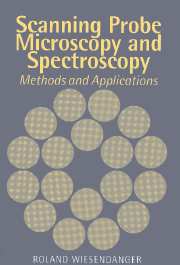Book contents
- Frontmatter
- Contents
- Preface
- List of acronyms
- Introduction
- Part one Experimental methods and theoretical background of scanning probe microscopy and spectroscopy
- 1 Scanning tunneling microscopy (STM)
- 2 Scanning force microscopy (SFM)
- 3 Related scanning probe methods
- Part two Applications of scanning probe microscopy and spectroscopy
- References
- Index
3 - Related scanning probe methods
Published online by Cambridge University Press: 05 October 2010
- Frontmatter
- Contents
- Preface
- List of acronyms
- Introduction
- Part one Experimental methods and theoretical background of scanning probe microscopy and spectroscopy
- 1 Scanning tunneling microscopy (STM)
- 2 Scanning force microscopy (SFM)
- 3 Related scanning probe methods
- Part two Applications of scanning probe microscopy and spectroscopy
- References
- Index
Summary
Scanning probe methods, such as STM and SFM discussed in chapters 1 and 2, represent a novel approach to surface analysis and high-resolution microscopy. Traditional surface analytical and microscopical techniques are based on an experimental set-up schematically illustrated in Fig. 3.1(a). The sample in the center of an UHV chamber is probed by electrons, photons, ions or other particles which originate from corresponding sources, typically at a macroscopic distance from the sample surface. As a result of the interaction of the primary electrons, photons, ions etc. with the sample, secondary particles are created and eventually leave the sample together with scattered primary particles. They can be detected by appropriate detectors and analyzers which again are typically a macroscopic distance away from the sample surface. The direction of the emitted particles as well as their energy contain valuable information about the sample under investigation. The spatial resolution achievable is determined by the spatial extent of the primary beam as well as the interaction volume within the sample.
In contrast, scanning probe methods are based on a completely different experimental geometry depicted in Fig. 3.1(b). A sharp probe tip is brought into close proximity to the sample surface until interaction between tip and sample sets in. The interaction is spatially localized according to the shape of the probe tip and the finite effective range of the interaction.
- Type
- Chapter
- Information
- Scanning Probe Microscopy and SpectroscopyMethods and Applications, pp. 265 - 288Publisher: Cambridge University PressPrint publication year: 1994
- 3
- Cited by



